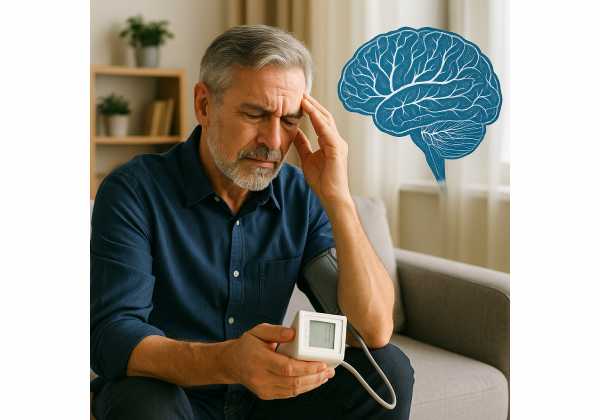
High blood pressure is common, often silent, and deeply relevant to how the brain ages. Over years, elevated pressure strains the brain’s smallest vessels, feeds micro-injury in white matter, and nudges thinking skills off course. The good news: blood pressure is measurable, modifiable, and trackable at home. With a few reliable habits—and a realistic plan with your clinician—you can reduce stroke risk, slow white matter change, and protect attention, processing speed, and memory. This guide translates current best practices into practical steps: how vessels and white matter are affected, how to measure at home with accuracy, when to escalate treatment, and ways to weave activity, sleep, and sodium awareness into daily life. If you want a broader view of maintaining thinking skills as you age, explore our cognitive longevity hub. Then come back here with your cuff, a notebook, and a plan.
Table of Contents
- Blood Pressure and the Brain: Small Vessels and White Matter
- Home Monitoring: Technique, Targets, and Trends
- Daily Levers: Activity, Sleep, and Sodium Awareness
- Medication Adherence: Working with Your Clinician
- When Readings Warrant a Plan Change
- Pairing BP Care with Hearing, Vision, and Fall Prevention
- Building a Binder: Logs, Appointments, and Lab Results
Blood Pressure and the Brain: Small Vessels and White Matter
The brain runs on a dense web of arterioles and capillaries that deliver oxygen and glucose to billions of neurons. Hypertension—systolic blood pressure (top number) persistently at or above 130 mm Hg, diastolic (bottom number) at or above 80 mm Hg, or both—gradually damages these small vessels. Over time, high pressure stiffens vessel walls, disrupts the lining (endothelium), and reduces their ability to buffer each heartbeat’s pulse. The result is “cerebral small vessel disease” (CSVD): microbleeds, tiny infarcts, and the progressive appearance of white matter hyperintensities on MRI. White matter acts like the brain’s wiring, connecting regions so information can move quickly and efficiently. When white matter is injured, processing speed slows; attention drifts; multitasking, planning, and gait can suffer.
Think of white matter health as a “throughput” issue. Vessels that can’t cushion pressure waves transfer stress downstream. The blood–brain barrier can leak, inflammation spikes, and myelin (the insulation around nerve fibers) thins. MRI shows these changes as bright patches—white matter hyperintensities—most commonly near the ventricles and in deep tracts that carry signals for movement and executive function. Clinically, these lesions correlate with higher risks of stroke, depression, and cognitive decline. They also interact with other threats: atrial fibrillation, diabetes, sleep apnea, and sedentary time magnify damage.
The protective flip side is equally concrete. Lowering sustained blood pressure exposure reduces strain on these microvessels and slows white matter change. Large trials of intensive blood pressure control have shown benefits for mild cognitive impairment and for white matter lesion progression, especially when a meaningful (and safe) drop in average systolic pressure is maintained. That’s why the brain longevity conversation belongs in every blood pressure visit—not just to avert strokes, but to preserve cognitive efficiency across decades. The goal isn’t one perfect number at a single appointment; it’s a stable pattern of safer pressures, day after day, that gives your brain more margin.
To get there, you’ll combine solid measurement habits, consistent lifestyle moves, and medication taken as prescribed. White matter health rewards steady effort. Even moderate improvements—10 mm Hg less on average, fewer spikes, more readings in your target range—translate into less vascular wear and tear. What you do at home is the backbone of that progress.
Home Monitoring: Technique, Targets, and Trends
Your home monitor is your most practical brain-protection tool. When you measure correctly, you and your clinician can see true patterns rather than clinic-day noise. Use an automated, upper-arm cuff validated by an independent registry. Replace cuffs every few years or sooner if readings become inconsistent.
Set up for accuracy:
- Avoid caffeine, nicotine, and exercise for 30 minutes before measuring.
- Empty your bladder.
- Sit quietly for 5 minutes with back supported, feet flat, legs uncrossed.
- Use the right cuff size (bladder encircling 75–100% of your arm). Rest your bare arm on a table at heart level.
- Don’t talk or text during the reading.
Build a reliable dataset:
- Take two readings each morning and evening, 1 minute apart, for 7 consecutive days before visits or medication changes.
- Discard day one; average the remaining days. Save raw readings, too.
- Between review periods, measure at least several times weekly to track trends and spot drift.
Targets to discuss with your clinician:
- Many adults benefit from an average home blood pressure below 130/80 mm Hg, as long as you feel well and kidney function and electrolytes remain stable.
- If you’re older, frail, or have orthostatic symptoms, individualized targets may be safer. Clarity matters more than aggressiveness.
What to track beyond the average:
- Time in target range (TTR): aim for most readings in your agreed “green zone” (for many, roughly 110–129 systolic and 65–79 diastolic at home). A rising TTR often predicts better control and fewer spikes.
- Morning surge: higher morning numbers suggest medication timing adjustments or sleep-related contributors (poor sleep, untreated sleep apnea).
- Variability: large day-to-day swings may reflect missed doses, excess sodium, pain, stress, or a cuff/technique problem.
Common pitfalls to fix right away:
- Measuring over clothing, dangling feet, or unsupported arm.
- Cuff too small (reads falsely high) or too large (reads falsely low).
- Single spot-checks instead of paired readings and weekly averages.
For more context on how small vessel changes accumulate, see our overview of small vessel disease basics. Accurate home data—not guesswork—drives the best decisions, especially when the goal is protecting white matter and cognition over the long term.
Daily Levers: Activity, Sleep, and Sodium Awareness
Medication works best on the foundation of daily habits that lower overall vascular stress. Three levers move blood pressure reliably and support brain longevity: physical activity, restorative sleep, and sodium awareness.
Activity: Aim for at least 150 minutes per week of moderate-intensity aerobic movement (brisk walking, cycling, swimming), plus two strength sessions focused on major muscle groups. Even 10-minute bouts reduce systolic pressure by 4–8 mm Hg when you add them up. Resistance training improves arterial elasticity and glucose handling; both matter for the brain’s microcirculation. If balance is a concern, weave in heel-to-toe walking, sit-to-stands, and single-leg holds near a counter. Short movement “snacks” after meals blunt postprandial spikes. Expect measurable improvements in 4–8 weeks.
Sleep: Poor sleep raises catecholamines and pushes morning numbers higher. Set a consistent schedule, target 7–8 hours, and keep the bedroom cool and dark. If you snore loudly, wake unrefreshed, or have resistant hypertension, ask about sleep apnea screening; effective treatment lowers pressures and may protect white matter by stabilizing oxygen delivery overnight.
Sodium awareness: Most sodium comes from packaged and restaurant foods, not the salt shaker. Practical steps:
- Scan labels for “sodium” per serving; aim for products with ≤140 mg per serving when possible.
- Cook more at home; flavor with lemon, herbs, vinegar, or potassium-rich seasonings if your kidneys are healthy and your clinician approves.
- Set a realistic target: many adults benefit from reducing intake by ~1,000 mg/day, with a common goal of ≤2,300 mg/day and, for some, closer to 1,500–2,000 mg/day. Expect systolic reductions of ~5–8 mm Hg within weeks when adherence is steady.
- Be cautious with salt substitutes if you have chronic kidney disease or take medications that raise potassium.
Weight, alcohol, and stress: Losing 5–10% of body weight often lowers systolic pressure by 5–10 mm Hg. If you drink, limit alcohol; some people see marked improvement by avoiding it altogether. Use brief, repeatable stress resets—paced breathing (six breaths per minute for five minutes), a short walk, or a 10-minute body scan. These techniques reduce sympathetic tone and tighten up blood pressure variability.
Stacking the habits: Pair your evening walk with a lower-sodium dinner. Charge your cuff beside your toothbrush as a measurement cue. Place resistance bands near your kettle. Small environmental tweaks convert intention into routine, which beats motivation alone.
For ideas that blend movement with brain challenge, try combining steps and simple tasks—an approach explored in our piece on thinking while moving—but keep it safe if balance is limited.
Medication Adherence: Working with Your Clinician
Most people need medication to reach and maintain safe pressures long term. That’s not a failure—it’s physiology. The aim is steady control with the fewest side effects, monitored with regular labs and home readings. Common first-line options include thiazide-type diuretics, ACE inhibitors, ARBs, and long-acting calcium channel blockers. Many patients start with a combination pill to simplify dosing and improve adherence.
Make the plan practical:
- One daily dose when possible. Fewer timing demands mean fewer misses.
- Combination pills: Lower pill burden, sometimes lower cost.
- Timing with purpose: If you see a pronounced morning surge, discuss evening dosing. If you wake at night to urinate, avoid late-evening diuretics.
- Side-effect troubleshooting: Cough with an ACE inhibitor? An ARB may be a cleaner fit. Swelling with a calcium channel blocker? Adding or adjusting a diuretic can help.
Adherence structures that work:
- A seven-day pill organizer you refill on the same day each week.
- Phone alarms or smart speaker reminders at dose time.
- Refill synchronization so all medications renew together.
- Mail-order or 90-day supplies to reduce pharmacy trips.
Lab and safety monitoring:
- After dose changes, check electrolytes and kidney function within 2–4 weeks, especially with ACE inhibitors/ARBs or diuretics.
- Ask about interactions with over-the-counter NSAIDs, decongestants, or herbal stimulants, which can raise pressure or reduce medication effect.
Cognition-aware prescribing:
- Review your medication list for drugs that impair attention or memory, particularly anticholinergic agents used for bladder, allergy, or sleep issues. Reducing unnecessary anticholinergic load can help thinking and blood pressure control. If this is a concern, see our quick guide to an anticholinergic review to prepare for your visit.
Expect a titration arc:
- Early on, your clinician will adjust medications every few weeks based on your home averages and how you feel. Once stable, visits space out, but you’ll continue monitoring at home.
Adherence is less about willpower than design. When the routine is simple, reminders are automatic, and side effects are addressed promptly, steady control follows—and so does protection for white matter and memory.
When Readings Warrant a Plan Change
Your home log tells a story. Certain patterns mean it’s time to act, not wait.
Red flags that deserve prompt contact with your clinician:
- Sustained averages ≥135/85 mm Hg at home over 1–2 weeks despite taking medication as prescribed.
- Frequent spikes into the 150s/90s, especially with symptoms (headache, visual changes, chest pain, shortness of breath, or new neurologic symptoms).
- Morning surge: most mornings ≥140 systolic while evenings are controlled—often a clue to timing, sleep apnea, or adherence issues.
- Orthostatic symptoms: dizziness when standing, near-falls, or systolic drops ≥20 mm Hg when you stand—especially if you’re older or on multiple agents.
- New swelling, cough, or muscle cramps after a medication change.
When to escalate therapy:
- If your average is above target after 4–6 weeks on a stable dose, you may need a dose increase or a second agent—preferably in a single combination pill to improve adherence.
- If three medications (including a diuretic) aren’t enough, ask about “resistant hypertension” evaluation (kidney ultrasound, primary aldosteronism screening, sleep apnea testing, medication review).
Situations calling for faster action:
- Hypertensive urgency: repeated home readings ≥180 systolic or ≥120 diastolic without symptoms—call your clinician the same day for instructions.
- Hypertensive emergency: those numbers with chest pain, shortness of breath, severe headache, confusion, vision loss, weakness, or speech difficulty—call emergency services.
Think brain first:
- Sudden weakness, facial droop, speech trouble, or vision loss are stroke warnings—time-sensitive emergencies. Fast treatment can limit brain injury and protect long-term cognition.
Finally, high blood pressure rarely travels alone. If your log creeps up and you notice heart palpitations, irregular pulse, or exercise intolerance, ask about screening for arrhythmias such as atrial fibrillation. Managing rhythm issues reduces stroke risk and strengthens your overall brain longevity plan; our overview of atrial fibrillation and stroke risk explains why coordination across conditions matters.
Pairing BP Care with Hearing, Vision, and Fall Prevention
Blood pressure control protects the brain directly, but its benefits multiply when combined with sensory care and fall prevention. Here’s how to build a protective package.
Hearing: Untreated hearing loss increases listening effort and social withdrawal, which can accelerate cognitive strain. Get a baseline hearing test if you ask people to repeat themselves, turn up the TV, or avoid noisy places. If hearing aids are recommended, early adoption supports attention and memory by reducing constant cognitive load. When blood pressure medications are adjusted, note whether you feel light-headed in busy sound environments and ask about timing tweaks.
Vision: Contrast sensitivity and low-light vision decline with age and can be worsened by vascular disease. Update prescriptions regularly, address cataracts early, and improve home lighting (task lights in the kitchen, motion lights on stairs). Good lighting plus steady blood pressure reduces missteps and near-falls.
Balance: White matter changes often affect gait speed and multitasking while walking. Combine BP control with balance routines: heel-to-toe walking along a counter, single-leg stands, and gentle strength drills for hips and ankles. If you notice unsteadiness, ask about physical therapy for individualized balance training.
Orthostatic safety: Some people—especially older adults—experience drops in blood pressure when standing, which can lead to falls. To reduce risk:
- Rise slowly, pause before walking, and use sturdy footwear.
- Review diuretic timing (avoid late evening if nocturia leads to groggy, risky bathroom trips).
- Check seated and standing pressures at home; share these with your clinician to fine-tune the regimen.
Home environment: Clear pathways, add grab bars where needed, and elevate commonly used items to waist height to avoid sudden bends.
Why this pairing matters for brain longevity: Falls with head injury threaten cognition. Sensory deficits increase cognitive load, raise stress hormones, and can raise blood pressure variability. Coordinating these areas turns your BP plan into a broader “brain safety” plan. For dizziness, imbalance, or spatial disorientation, see our guide to vestibular care.
When you combine controlled pressure, sharp senses, and confident mobility, you reduce the daily risks that chip away at attention, processing speed, and memory.
Building a Binder: Logs, Appointments, and Lab Results
A simple, organized system turns scattered readings into actionable decisions. Whether you prefer paper or an app, build a “BP and Brain” binder with these sections:
1) Home readings.
- Keep a monthly log of morning and evening paired readings with dates and times. Circle weeks used for clinical decisions.
- Add a one-page monthly summary: averages, time in target range, morning versus evening comparison, and any symptoms.
2) Medications.
- Current list with doses, timing, and purpose for each medication.
- A history page noting what you’ve tried, why changes were made, and any side effects. This helps avoid repeating past problems and supports safer future choices.
3) Labs and imaging.
- Blood work after medication changes (electrolytes, kidney function), annual labs, and, when relevant, lipid panel and A1C.
- If you’ve had brain imaging, keep dates and key points so you and your clinician can discuss trends (for example, white matter changes).
4) Visit notes and questions.
- Before each appointment, list questions in priority order: “Why are mornings higher?” “Can we simplify to one pill?” “Do I need a sleep apnea test?”
- After the visit, summarize the plan in plain language: “Increase ARB to 80 mg daily, move diuretic to morning, check labs in 2 weeks, re-average readings for 7 days, target home average <130/80.”
5) Lifestyle tracking.
- Weekly activity minutes, sodium goals, alcohol intake, and sleep duration.
- Short notes on stressors, pain flares, or travel—context that explains outlier readings.
6) Emergency section.
- A one-page action plan for high readings and stroke symptoms, including who to call and where to go.
How to maintain it with minimal effort:
- Reserve 15 minutes on the same day each week to update the binder.
- Store it with your cuff so measurement and logging happen together.
- Bring it to every appointment, or export a clean PDF from your app.
A clear record speeds up visits, improves decisions, and keeps you and your clinician aligned on the same goals: steady control, fewer spikes, and better brain outcomes. Over months and years, the binder becomes evidence of what works for you—a personalized playbook for protecting white matter and memory.
References
- 2025 AHA/ACC/AANP/AAPA/ABC/ACCP/ACPM/AGS/AMA/ASPC/NMA/PCNA/SGIM Guideline for the Prevention, Detection, Evaluation and Management of High Blood Pressure in Adults: A Report of the American College of Cardiology/American Heart Association Joint Committee on Clinical Practice Guidelines 2025 (Guideline)
- Effect of Intensive vs Standard Blood Pressure Control on Probable Dementia: A Randomized Clinical Trial 2019 (RCT)
- Association of Intensive vs Standard Blood Pressure Control With Cerebral White Matter Lesions 2019 (RCT/MRI Substudy)
- Self-Measured Blood Pressure Monitoring at Home: A Joint Policy Statement From the American Heart Association and American Medical Association 2020 (Guideline/Policy Statement)
- Effect of Dietary Sodium on Blood Pressure: A Crossover Trial 2023 (RCT)
Disclaimer
This article provides general information for adults about managing blood pressure to support brain health. It does not replace personalized medical advice, diagnosis, or treatment. Always consult your clinician before making changes to medications, targets, or monitoring routines, especially if you have kidney disease, diabetes, heart rhythm disorders, or symptoms such as chest pain, shortness of breath, severe headache, neurologic changes, or fainting.
If you found this useful, please consider sharing it with friends or on Facebook, X, or your preferred platform, and follow us for future updates. Your support helps us continue creating clear, trustworthy health content.










